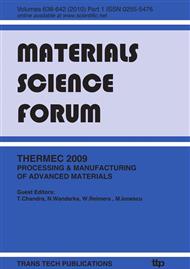p.652
p.658
p.664
p.670
p.675
p.681
p.687
p.693
p.700
Comparison of the Cross Sectional Area, the Loss in Volume and the Mechanical Properties of LAE442 and MgCa0.8 as Resorbable Magnesium Alloy Implants after 12 Months Implantation Duration
Abstract:
Current research focuses on magnesium based alloys in the course of searching a resorbable osteosynthetic material which provides sufficient mechanical properties besides a good biocompatibility. Previous studies reported on a favorable biocompatibility of the alloys LAE442 and MgCa0.8. The present study compared the degradation process of cylindrical LAE442 and MgCa0.8 implants after 12 months implantation duration. Therefore, 10 extruded implants (2.5 x 25 mm, cross sectional area 4.9 mm²) of both alloys were implanted into the medullary cavity of both tibiae of rabbits for 12 months. After euthanization, the right bone-implant-compound was scanned in a µ-computed tomograph (µCT80, ScancoMedical) and nine uniformly distributed cross-sections of each implant were used to determine the residual implants´ cross sectional area (Software AxioVisionRelease 4.5, Zeiss). Left implants were taken out of the bone carefully. After weighing, a three-point bending test was carried out. LAE442 implants degraded obviously slower and more homogeneously than MgCa0.8. The mean residual cross sectional area of LAE442 implants was 4.7 ± 0.07 mm². MgCa0.8 showed an area of only 2.18 ± 1.03 mm². In contrast, the loss in volume of LAE442 pins was more obvious. They lost 64 % of their initial weight. The volume of MgCa0.8 reduced clearly to 54.4 % which corresponds to the cross sectional area results. Three point bending tests revealed that LAE442 showed a loss in strength of 71.2 % while MgCa0.8 lost 85.6 % of its initial strength. All results indicated that LAE442 implants degraded slowly, probably due to the formation of a very obvious degradation layer. Degradation of MgCa0.8 implants was far advanced.
Info:
Periodical:
Pages:
675-680
Citation:
Online since:
January 2010
Price:
Сopyright:
© 2010 Trans Tech Publications Ltd. All Rights Reserved
Share:
Citation:


